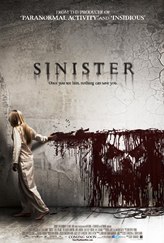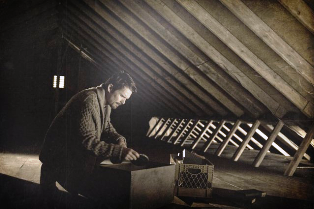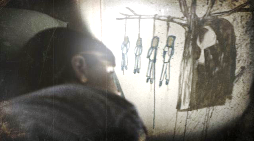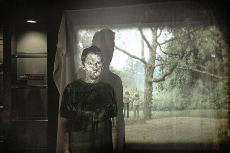
Wednesday, I watched an advanced screening of Sinister in Atlanta, GA. After the film ended, Scott Derrickson and C. Robert Cargill did a small Q&A session for the public. Cargill and Derrickson had originally got together over mutual respect, for Derrickson’s film works and Cargill’s reviews as Massawyrm at Aintitcool.com. They mentioned that the Cargill came up with the concept for the film after going to bed immediately following a viewing of The Ring. Many of the topics that were questioned by the audience involved heavy spoilers, but there were a few exceptions where I reference the previous night. The last thing they mentioned, which I find amazing, is that the final budget wound up about 3 million.
Clint: Let me start off by saying I really enjoyed the movie.
Cargill and Derrickson: Thanks
Clint: I heard more “Oh Gods” last night than I ever heard before in my life. With horror changing the way that it is and everyone going towards this video on demand, you guys are going through with just a theatrical release right?
Cargill: Yeah. Well it’s not that everyone in horror is going VOD, it’s that there’s a wonderful model going on for independent horror, and it’s mostly done by Magnet and Magnolia, and I think their model is really fantastic. Because they’ve done a great job of pushing films that otherwise would have ended up direct to video, fall by the wayside and they can actually be considered respectable. Nobody looks at a film like Kill List or The Innkeepers as being just direct to video movies. They get that feel that they are truly independent films, but at the same time a lot of those films are just niche. You know V/H/S just doesn’t have as wide appeal as something like.
Derrickson: Sinister
Cargill: Well I was going to mention, I mean not compare us directly. I was going to actually say The Possession, that has more of a narrative that audiences can follow. Because V/H/S, it’s a complicated film for average audiences.
Clint: Glad you bring that up. Great year for horror. With your film and V/H/S…
Cargill: Cabin in the Woods, The Collection, there’s so much good stuff out there right now. There’s so much happening in the world of horror right now. A lot of it is driven by the VOD releasing, because it’s saying we can take chances and we can be daring in our horror. We just made a film that was intended to be a…
Derrickson: Accessible to mainstream.
Cargill: We wanted to make an accessible film that scared the crap out of people and we didn’t find the need to be too esoteric with it. One of the things at the heart when we first talked about how we wanted to do it, I was a huge horror fan when I was little, or a teenager, but there were a lot of films I wasn’t able to see because they were way too violent or had too much sex and my parents were just like “oh, you can’t watch that”. I wanted to make something that would be accessible to a teenager and would scare the crap out of them but then would also but would also grow up with them that they would never feel like “oh, that was a good movie when I was 13”. I wanted to make something that played to everyone but had that accessibility and could be truly scary, that could be something that could haunt you for years. That’s essentially where we went with that. And as it turned out it played well enough at the test screening that Summit is taking it very wide. And we’re very proud of that.
Clint: How do you guys feel about the experience of having a full crowd there? Have you guys walked in, like in Fantastic Fest last week?
Derrickson: Yeah, we’ve walked in with audiences and seen the whole thing. It’s awesome. It’s really satisfying to watch people get uncomfortable and you can tell when a movie is getting under the skin of the audience. And that seems to be happening. And then I think that the audience relief and laughter at the Deputy So and So character plays really satisfying. And of course, watching a whole room of 200 (or) 300 people all flinch at the same time is great.
Clint: After the movie last night, Cargill had said that he was worried about people saying it sucks while watching it at fantastic fest, and I don’t know how that could have been as I heard a lot of participation going on around me.
Cargill: There’s always that fear. You’ve been a critic for a while, so you know that if you took everyone from Chud, Chud has a very kind of, you know you guys are not all over the map by any means or stretch of the imagination, but you guys have general tastes in common. You put all you guys in a room together and show a movie, are you guaranteed that you are all going to love it or you’re all going to hate it. No. No way. Watching film, half of what film is, is what the artist brings to it and the other half is what you, the audience member brings to it. And so you can never tell. There’s always that fear that you’re going to have audience member, especially people you have been colleagues with or friends with for a long time, who are just not going to like it. And you can’t help that. The people you really feel that from are the people who you really respect and you love. There’s always that.
Clint: I’ve been a huge horror fan for a very long time. Similar to yourself (Cargill). To me the situational, atmospheric horror is much more impactful and editing, to make that edit of the long takes that you did, I’m sure that has to be a challenge to you (Scott), how do you get by with that without wanting to cut it short?
Derrickson: You have to be prepared and disciplined and know the tone and the pacing of your whole film to do that, because if you get those wrong takes wrong, you’re fucked. There’s nothing you can do to fix it. I think that part of that was driven by the budget, because if you do a long take with two actors moving through the house in a single take, it takes longer to setup, but you can also knock out 3 or 4 pages of dialogue with one take and ultimately save time. That wasn’t the biggest motive. In the performance scenes when they were long takes, when you have really good actors like Juliet(Rylance) and Ethan (Hawke) it give them a freedom to create a dynamism in that single master shot that you don’t get when you start cutting that. You don’t have that when you start to break it up. There’s something that gets lost in it. Providing them an arena to really come alive. If you watch Spielberg’s films he does that all the time. It allows actors to get to a place of pure energy and realism and it also creates and effect on the audience because once you cut there’s an artificial reality to it. You don’t cut in real life. I think that having patient confidence in horror film that some of those longer takes and using the right sound, the right music and the right atmosphere, audiences really feel, I think they feel a respect coming from the movie to them. A kind of “We trust you to be with us and to get into this”, and the Paranormal (Activity) movies, say what you want about them, talk about long takes…. That’s what I admire most about those movies, how unconventional that approach is, it’s almost like an Antonioni film. Compared to what you would get out of the super cutty, super hyper energy kind of film making. For this particular movie it just made sense. The filming style for the movie for the story we were telling just made sense.
Clint: How does that feel for you (Cargill)? Being that you did the writing part and you get to sit back and watch these long takes go on. Does it frustrate you at all? You’ve been a critic for long enough to understand the whole process.
Cargill: Oh no, I loved it. One of the things we talked about while making the film, we just talked about accessibility, at the same time we spent a lot of time talking about stylishness. Essentially while we were making a mainstream film, we were making a mainstream film with indie sensibilities is what it came down to. How it dealt with the drama. We have a six page scene of two guys sitting around a table having a discussion, we have a five minute long fight scene. The types of things you don’t traditionally see in mainstream films.
Derrickson: You never see in horror films.
Cargill: Well you do, but you don’t see like the argument.
Derrickson: James Ransome is friends with Ty West and he told Ty before we shot the movie that script is (imitating James Ransome)“Really interesting. I’ve got a five page dialogue scene in a living room sitting down with Ethan Hawke”, and Ty West said that will be a great extra on the DVD. (laughs)
Clint: Speaking of masters of long shots. He goes for more atmospheric than just about anything else.
Cargill: What it did was it felt really great. I’m sitting there watching these sequences that Scott is shooting and they were just fantastic.
Derrickson: When we were shooting the fight scene, the first full take we ran through the entire take of the fight scene. Cargill and I were standing at the monitor, we were in the bathroom in the bedroom. That’s where our monitor was. We finished up and we called cut. I looked at Cargill and said “Name another horror film in the history of horror that has a scene like that.” And he thought about it and goes “I can’t”. That was a great moment for me when I realized that we really were trying to do something different.
Clint: I noticed the house setting. When (Hawke) was looking down the hall it sometime resembled a hotel type setting or an old hospital type feel. Was that something you went out for?
Derrickson: For sure. The starting point with the production designer, we shot in New York so I knew it was going to be a challenge. (I said) What I don’t want is the typical two story scary looking house that we’ve seen from Psycho to Amityville to Haunting in Connecticut, or the hotel in Shining or the manor in The Changeling. They’re always these big scary looking places. I just want a flat single story ranch house. Those aren’t haunted houses. And part of it was the exterior look of it, the untypical nature of it. I said also I want long hallways. Knowing that there would be a lot of Ethan moving through those hallways, moving through those corridors and having the thrill of those hallways. I find hallways scary. I had a long hallway where my bedroom was.
Clint: And there are never good lights in hallways.
Derrickson: Exactly. At night, they just are scary. We also got a little lucky, because that main hallway where the ladder comes down is freakishly big. It is a very strange hallway. When we walked into that house I was like “This is it”. When you look at the hallway it’s huge, it’s giant. It’s like a hotel hallway. What’s strange is it’s this very large, very wide, unusually tall space with no doors. There’s some French doors that lead outside, but the rest of the hallway is just this long hallway and there’s really no reason for it to be that large. But it is, and that’s what I though was cool.
Clint: It was at the end of the movie when (Hawke) is walking in it, it reminded me of the shining as far as the long shot of the hallway went. It definitely had it’s own luminescence going into it and the blue lighting set it apart.
Cargill: The biggest thing that I hate about most haunted house movies is that it reaches a point at which any rational person would not stay in the house anymore, once you question that and someone stays in the house, the effect is lost. We were trying to avoid that situation. We want to make something creepy and scary that had lots of elements to it that you would understand that Ellison (Hawke) wouldn’t leave the house.
Clint: What are your plans after this? If it does well, are you planning on a sequel?
Derrickson: If it does well, we would like it to be a franchise. I think there are a lot of ways to go. What we’ll do is something original. We don’t want to do here’s the box in another house. We don’t want to make the same movie over and over again. We have other things we are working on, we have written, we have a sci-fi script that we have the first draft of, and we have other project that we are developing, we have another project at IM global that we’re working on, so we’re busy.
Clint: And your(Cargill) book is…
Cargill: Dreams and Shadows. It comes out in February from Harper Collins. I’m really proud of it.
Clint: What genre?
Cargill: It’s dark fantasy. Urban fantasy. Little horror spattered in but mostly fantasy. The story of two boy that are brought together by supernatural means when they’re kids and how the events of their childhood ultimately affect and screw up their lives. And that’s coming out shortly.
Clint: What other movies would you say influenced this (Sinister)? I know you had mentioned the some older horror. Anything more current? Or mostly older….
Derrickson: We were mostly pulling from older films. Do you remember the films I talked about (from the Q&A the previous night)?
Clint: The Omen, The Shining.
Cargill: The Changeling.
Derrickson: You know, also visually Klute was the biggest influence on the look of the film. I gave a copy of that to the DP, Gordon Willis’ black photography. The darkness in that is so dark and so much of the frame is dark. I really liked that. So that was a big influence. Did I mention Blow Out last night?
Clint: You did. Definitely. It’s all over the place.
Cargill: One of the biggest things in modern film that had an effect on us, we talked a lot about not wanting to borrow from a lot of other modern films. We wanted to try to feel like our own thing. There were times when we had an element and we were like why don’t we do this? Because that’s in The Ring. Or that’s straight out of Let the Right One In. We wanted to stay really away from that. So we avoided a lot of those elements that wouldn’t feel fresh or that we were borrowing.
Derrickson: I think the only modern real influence was the entire assistance of the found footage genre. And wanting to build on top of that, which was to make a film not really about the film, but about the guy who finds the found footage. That just seemed to make sense. That being the next evolution, or A evolution of the genre.
Clint: I definitely think that found footage films, to me, aren’t that appealing, but the stuff that is being done with them right now.
Derrickson: It’s getting interesting
Clint: It is.
Derrickson: I thought the same thing.
Clint: V/H/S I loved.
Derrickson: I think that once you abandon just the simple gimmick of it and try to…
Clint: Make something different.
Derrickson: Make something different with it. And make something where you’re not constantly tripping over the logic of it. Why are we still shooting and that kind of thing. You can make some interesting stuff.
Clint: Do you have anything else you want to say?
Cargill: We hope people enjoy it. We really, I mean we really hope it scares people. Above all, we set out to make an entertaining film, but above all we set out to make a film that we want …. Ultimately…. You know there are a few people that gave it mixed reviews that said they didn’t like certain elements of it. But that it was scary. We consider that…. At the end of the day, if we scared you, then we’ve done our job. We’ve given you the experience we promised you. We feel me made something that delivered on that.



